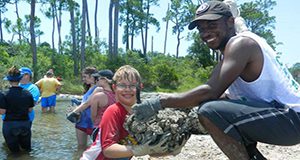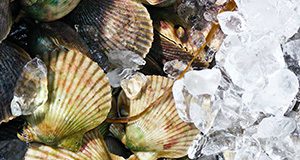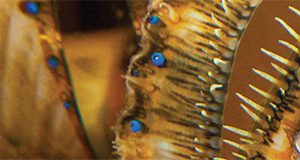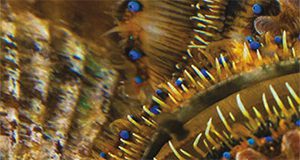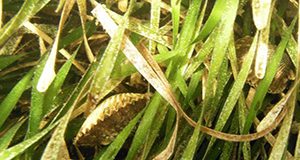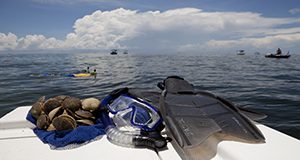American horseshoe crabs (Limulus polyphemus) look prehistoric and in fact really have not changed very much in the 200 million years they have been around. This 3-page fact sheet written by Savanna Barry, Holly Abeels, and Shelly Krueger and published by the UF/IFAS Program in Fisheries and Aquatic Sciences, School of Forest Resources and Conservation tells the story of these interesting and valuable “living fossils,” including their importance both to ecology and human medicine. It provides tips on how to find horseshoe crabs and a few ways you can help them.
https://edis.ifas.ufl.edu/sg190
Tag: Savanna Barry
A Homeowner’s Guide to the Living Shoreline Permit Exemption Part 2: United States Army Corps of Engineers
Living shorelines are coastal shoreline stabilization interventions that rely on natural elements such as native vegetation and oyster reefs to protect property. The US Army Corps of Engineers, among other entities, regulates the placement of living shorelines through a permitting process to ensure project activities do not conflict with the public interest. In this 9-page guide, authors Savanna Barry, Sara Martin, and Eric Sparks provide you with example text for each application section that you can adapt to your needs to assist you in filling out the permit application. Published by the UF/IFAS Florida Sea Grant College Program.
http://edis.ifas.ufl.edu/sg189
A Homeowner’s Guide to the Living Shoreline Permit Exemption Part 1: Florida Department of Environmental Protection
“Living shoreline” is a term that describes coastal shoreline stabilization interventions that rely on natural elements such as native vegetation and oyster reefs to protect property. Living shorelines typically involve construction or placement of materials within state waters (public lands that occur waterward of the mean high tide line). The Florida Department of Environmental Protection and other entities regulate the placement of living shorelines through a permitting process to ensure project activities do not conflict with the public interest. To streamline the approval process for environmentally beneficial projects such as living shorelines, the DEP has defined an exemption for small-scale living shoreline projects that meet certain criteria. This 17-page fact sheet written by Savanna Barry, Sara Martin, and Eric Sparks and published by the UF/IFAS Florida Sea Grant College Program provides a guide to completing the exemption forms.
http://edis.ifas.ufl.edu/sg187
Best Practices for Scalloping: From the Boat to Your Plate
Recreational scalloping in Florida is a popular group activity for many residents and visitors throughout the summer months. This 6-page fact sheet written by Brittany Hall-Scharf, Sarah Ellis, and Savanna Barry and published by the UF/IFAS Florida Sea Grant College Program lists the legal requirements for boating and scalloping, provides a safety plan to minimize and/or prevent accidents while you’re out on the water, and explains proper shucking methods to ensure that the meals you make from your catch will be safe and delicious.
https://edis.ifas.ufl.edu/sg158
Recreational Harvesting of the Florida Bay Scallop: Wakulla County
This handy brochure includes a full-color map identifying access routes to the boat ramps and marinas in Wakulla County, plus the latest information on scallops and scalloping, the recommended equipment you will want to bring, and a few tasty recipes for preparing Florida’s best summertime catch. Written by Savanna Barry and published by the UF/IFAS Extension Florida Sea Grant College Program.
http://edis.ifas.ufl.edu/sg149
Recreational Harvesting of the Florida Bay Scallop: Citrus County
This handy brochure written by Savanna Barry and published by the UF/IFAS Florida Sea Grant College Program includes a full-color map identifying access routes to the boat ramps and marinas in Citrus County near Homosassa and Crystal River, plus the latest information on scallops and scalloping, the recommended equipment you will want to bring, and a few tasty recipes for preparing Florida’s best summertime catch.
http://edis.ifas.ufl.edu/sg147
Responsible Boating Protects Seagrass Meadows
Florida leads the country in the number of registered recreational watercraft, with between 867,463 and 921,834 vessels in the state. With so many people out enjoying Florida’s waters, there is significant risk of damage to sensitive coastal habitats such as seagrass meadows. This 4-page fact sheet written by Savanna Barry, Ana Zangroniz, and Joy Hazell and published by the UF/IFAS Florida Sea Grant College Program explains the importance of protecting seagrass meadows by responsible boating and gives tips to boaters about how to practice seagrass-safe boating.
http://edis.ifas.ufl.edu/sg151
Responsible Boating Protects Coral Reefs
Florida is often referred to as the boating capital of the nation, with more than 930,000 registered vessels. Florida’s numerous natural resources such as mangroves, seagrasses, estuaries and coral reefs are a major draw to resident and visiting boaters alike. Outdoor activities associated with boating, such as birding, fishing, swimming, snorkeling, and diving, contribute to the state’s economy. However, increased traffic on the water can bring potential risks, particularly to sensitive ocean bottom habitats such as coral reefs and seagrasses. This 4-page fact sheet written by Ana Zangroniz, Savanna Barry, and Joy Hazell and published by the UF/IFAS Florida Sea Grant College Program gives an introduction to the corals and coral reefs of Florida, provides ecological and economic information, and lists simple steps to ensure that safe boating practices reduce physical impacts on coral reefs.
http://edis.ifas.ufl.edu/sg152
Recreational Harvesting of the Florida Bay Scallop: Citrus County
This publication includes a full-color map identifying access routes to the boat ramps and marinas in Citrus County near Homosassa and Crystal River, plus the latest information on scallops and scalloping, the recommended equipment you will want to bring, and a few tasty recipes for preparing Florida’s best summertime catch. Written by Savanna Barry and published by the Florida Sea Grant College Program.
http://edis.ifas.ufl.edu/sg147

